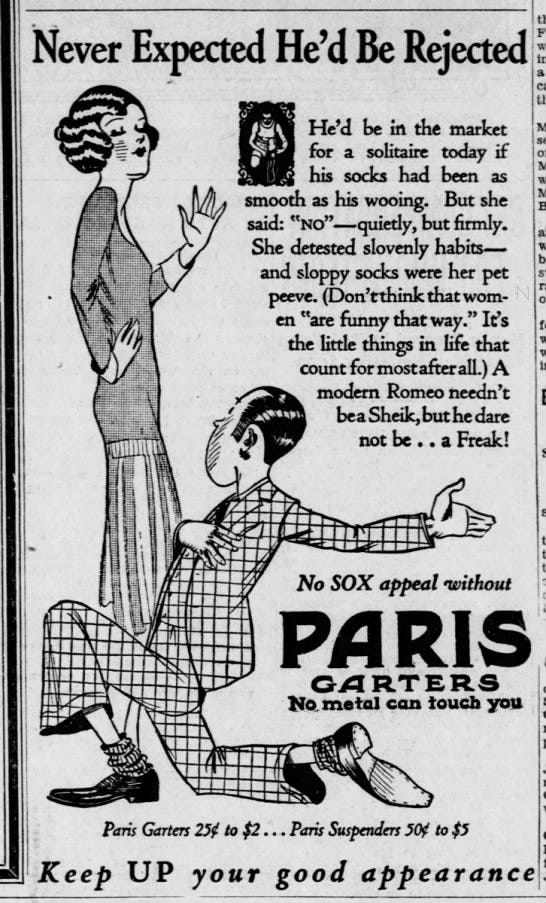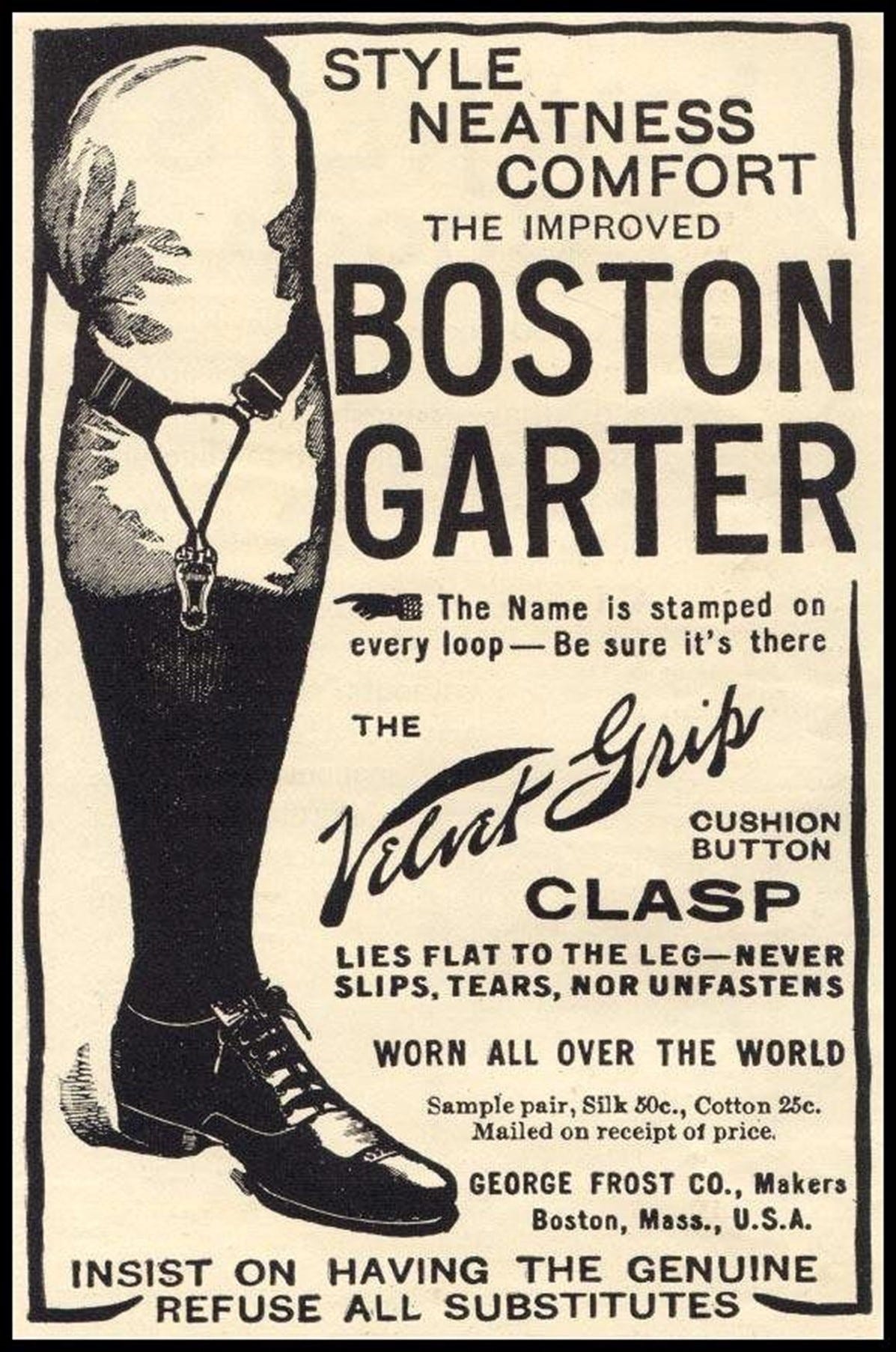Once upon a time, socks didn’t stay up by themselves. They needed a little help.
Some might remember being admonished as a child to “pull up your socks.” In the days before socks were made with elastic around the tops, sock garters or sock suspenders, were the key to a neat appearance for young children.
They were especially important to men wearing fashionably long socks with their business suits. Sock garters ensured a smooth line. No baggy wrinkles about the ankles or unsightly skin showing when a man crossed his knees.
Simple garters, consisting of a strip of cloth or ribbon tightly tied around the leg at the top of the stocking with the stocking top or hem rolled over it, existed in the early 1600’s and probably before. The garter flashes, decorating the garters worn by the Scots Guards of the Foot Regiment of the British Army, date back to 1642. And before that, during the reign of Queen Elizabeth I, elaborately decorated cloth garters were worn by fashionable ladies (and men) to keep their stockings and hose properly smooth and in place. Native Americans also used leg garters as part of their clothing accessories.

Sock garters with clips like the ones in our collection appeared in the late 1870s-early 1880s. The George Frost Company of Boston, MA referenced 1879 as when “well-dressed men have enjoyed the satisfaction afforded by the Boston garters.”
George and Almira Frost and their family moved to Roxbury, MA in the summer of 1850. The census lists George as a “dry goods merchant.” At that time, they had one daughter, Melissa. In 1856, daughter Adeline was born, followed by son, George A. Frost, in 1857. The 1880 census lists the family as living in Newton, MA. George was a “dealer in factory goods.” Son, George A was working in the family business. The company first began in selling “dry goods” and then “ladies furnishings.” It was located on Devonshire St. in Boston. In 1878, following a fire, the company rebuilt and began manufacturing the “Gentlemen’s Boston Garter.” It was a successful move. The company incorporated as the George Frost Company in 1891. By the early 1900’s facilities had expanded to multiple factories in Boston as well as mills in Connecticut and New Jersey.
“Boston Garter” and “Velvet Grip” Hose Supporters were trademarks of the George Frost Company.
The George Frost Company was just one of many sock garter manufacturing companies in the 1880s to 1920s. The George Frost Co., Pioneer Suspender Company, Crown Suspender Company, S.H.&M Co., A. Stein & Company, and Hickok were the leading companies in the U.S. Most of these companies had trademarked names for their garters. Brighton, Boston, Gordon and Paris were a few of the names.

Competition was fierce with newspaper ads across the country. In 1912, one of the George Frost Co. ad campaigns included trade cards of baseball players showing off their garters. Each card features a player “in the dugout, without pants, in the midst of getting dressed, proudly displaying his Boston-brand garters.” The collection of cards is still popular among sports memorabilia collectors. In 2013, a series of 5 cards, un-separated and in pristine condition, sold for a winning bid of $177,750.
The sock garters in our collection are made by The Hickok Manufacturing Company of Rochester, NY. They have Bakelite grippers and clips. Leo Hendrik Arthur Baekeland invented Bakelite in 1907. Patented in 1909, Bakelite is recognized as the first synthetic plastic.
The Hickok Manufacturing Company was started in 1909 as a jewelry plating company by Stephen Rae Hickok. Within 11 years, it had grown to be a national company making men’s accessories including, belts, suspenders, tie clips, and sock garters. Raymond P. Hickok, son of the founder, is known for creating the Hickok Belt Award which was awarded to the best professional athlete from all sports. The trophy was award annually 1950 – 1976 and then begun again in 2012. The Hickok Company also developed a prototype of the car seat belt. The company closed in 1972.
Sock garters continued to be popular into the 1920’s. Then in 1929, Lastex, an elastic yarn with a core of latex wound with cotton, rayon, nylon or silk threads. It changed the sock industry. During the 1930s elasticized socks began to replace the need for sock garters.
Fashion comes and goes. In the late 1940s and1950s, the fashion of lean, slimly styled business suits required socks that fit the slim line. Sock garters were once more in the picture. Esquire magazine ran a series of articles and ads. The November 1, 1950 Esquire cautions men to “select accessories carefully, wear them correctly!” The article featured a collection of coordinated accessories in the “new Tottem checks” including “Braces and garters are Tottem too.”
If you think that sock garters are a thing of the past what with the more casual styles of today, think again. Many athletes use them including ice hockey and baseball players. Over 300 sock garter items are available online from Amazon.
Thank you for reading. I’d love to hear your story or comment.
You can help grow History Buzz by sharing this post. It’s easy! To share this post via email use the Share button below, then click on Copy Link, and paste that into your email to Share the Buzz. Or use one of the other social media options.
Please leave a comment, share the post and help us spread the word about History Buzz.
Resources
Andover Center for History and Culture collection records 1995.076.15ab
https://histclo.com/fashion/store/mail/cou/us/chron/920/26/b26bg.html
http://garterblog.ru/en/no-metal-can-touch-you-the-short-and-stylish-life-of-socks-garters/
https://vintagedancer.com/vintage/history-vintage-mens-socks
https://robertedwardauctions.com
https://www.brooklynmuseum.org/opencollection/objects/63454
Moakley Archive and Institute www.suffolk.edu/moakley
https://witness2fashion.wordpress.com/2016/12/10/sock-suspenders-garters-for-men/
http://hickokbelt.com/index.php/about/history









And every Boy Scout in the world in summer dress outfit also wears garters to keep the knee socks in place. I still have mine someplace. And we Scot's still have them too!
I recall wearing a garter belt once I was old enough to wear stockings -- my father always wore garters for his sox when he dressed up (we thought they were so funny!) -- & my son wore the garters for his hockey sox when he was younger! We had generations of garter wearers!!